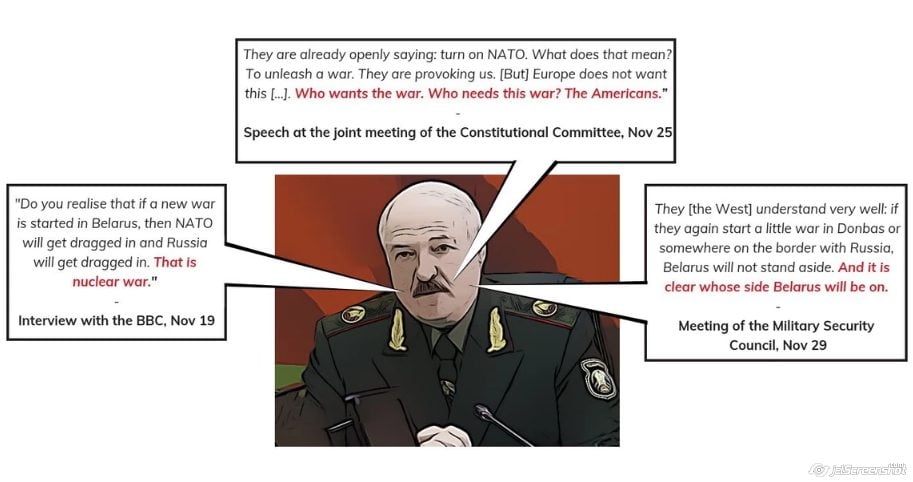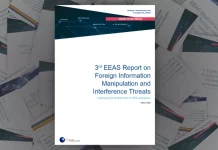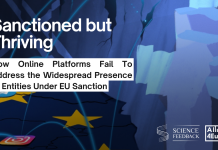By Laima Venclauskienė, for DebunkEU.org
After a major crackdown at the Belarusian border with Poland in the beginning of November, known disinformation sources were publishing 18 times more articles about the migrant crisis. Threats about a possibility of a military conflict between NATO and Russia, and accusations thrown at the West for exacerbating the situation at the border made by Alexander Lukashenko only added on to the efforts to spread disinformation about the migration crisis manufactured by Minsk.
On November 8, in an escalation of several months-long migrant crisis on Belarusian border with EU member states, a crowd of several hundred illegal migrants, escorted by the Belarusian officers, tried to break through the Belarus–Poland border near Bruzgi, Grodno Region. The number of articles on our object of analysis skyrocketed from the maximum of 39 posted by pro-Kremlin media in the first week of November to a whooping 617 in the second week of the month. Simultaneously, the number of hits grew within the coverage by media sources of migrant countries of origin.


Daily dynamics of articles, November 1-15
In November, Alexander Lukashenko continued to be the most quoted person within the coverage related to the migrant crisis on the border of Belarus and Lithuania. The first comments by Lukashenko after the events that unfolded on November 8 came out a day later, via his statements made in a several hours long interview to Igor Korotchenko, Editor-in-Chief of the Russian magazine Natsionalnaya Oborona (National Defense). An excerpt from the interview was soon aired on the 60 Minut talk show on the state TV channel Rossiya 1.
When commenting on the situation with migrant, Lukashenko stated that ‘waging a war on these miserable people at the Polish border with, let’s say, Belarus and deploying columns of tanks’ is ‘some drill or blackmail.’ According to him, ‘We [Belarus] don’t seek a fight like some people in Russia write, as well as our fugitives. Because we know that if, God forbid, we make some error, if we falter, then Russia will become immediately involved in this vortex. And Russia is a major nuclear power.’
Lukashenko has been repeating the narrative of the threat of an armed conflict for several months in a row. After the events of November 8, the Kremlin’s support for the Lukashenko regime in the information field has clearly increased, with Foreign Minister Sergei Lavrov and the ministry’s Director of the Information and Press Department Maria Zakharova becoming some of the leading spokespeople about the migrant crisis. This has become a kind of encouragement for Lukashenko to drop hints of a physical attack or even nuclear war.
Traditionally loud statements about the threat of a full-fledged military conflict continued in the second half of the month. This narrative was repeated during Lukashenko’s interview with the BBC, visit to the migrant camp in a warehouse in Bruzgi near the Polish border, and meetings with the country‘s (top) officials, special services and/or the military.


The interview with BBC was supposed to become Lukashenko’s platform to spread anti-EU (and anti- “collective” West) propaganda – something that made the interviewers strongly consider whether Lukashenko should be given air on BBC at all.
During the talk with Steve Rosenberg, Lukashenko again reiterated his claims from the beginning of the month – that if the conflict on the border with Belarus escalates, NATO and Russia will be immediately involved, which will trigger a nuclear war. Leaving aside the fact that this is an overly hasty conclusion, Lukashenko immediately accused the West of interfering in Belarusian affairs.
Notably, the whole interview was also broadcasted on Belarusian state TV. Media-IQ fact-checkers found out that many parts of the talk were omitted in the version shown on Belarus 1, e.g., questions about how many people were protesting after the election in 2020, Lukashenko’s spiteful remarks about the opposition, and most importantly, his open admission of protesters being beaten up in Okrestino prison – only remarks about police officers suffering injuries and the West staging the protests were left in.
Interestingly, Lukashenko’s admission that Belarusian officers might been helping migrants cross the border with Poland was left in the TV report. In this way, he is sending a message to the local audience to show that he understands ordinary Belarusians who cannot stand aside when they see the migrants suffering. This way Lukashenko once again suggested that the West is watching in cold blood, while the Belarusians, being “Slavs with hearts”, must help out the people in need.
During the speech at the joint meeting of the Constitutional Committee on November 25, Lukashenko stated that ‘the U.S. wants to start a war by using the hands of Poles, Balts and Ukrainians’. At the same time, he again pointed out that if a war is unleashed in Belarus, it will involve the West and Russia, which means a nuclear war.
Notably, Lukashenko accused Poland of using the migrant situation for political purposes, which is the overthrow of his regime, the so-called ‘colour revolution’. This rhetoric was also used after the election in 2020 when Lukashenko accused the ‘United States and its satellites’ of enticing the protests and sponsoring the opposition.
Talks about the colour revolution became some sort of mantra for Lukashenko which he uses to deflect attention from other issues. Talks about the West organizing a turmoil in Belarus in the context of the constitutional changes might be a way to deflect the attention from what these changes really entail – to grant Lukashenko access to power even if he is not the president. Notably, Lukashenko has previously said that he would step down as president once the new constitution is adopted, but in recent months he has stopped mentioning such a possibility.
With speeches about a colour revolution Lukashenka also pivots the attention from Belarus when it comes to the migration crisis at the border – with blaming the West for causing the turmoil after the election, the rhetoric about Europe ‘carrying out special operations’ fits well into the overall propagandist narratives used by both Minsk and Moscow.
The fear management strategy was not abandoned in the end of the month as well. Speaking at a meeting of the Military Security Council on November 29, Lukashenko ordered his army to prepare for NATO aggression and for a ‘small war’. His words were disseminated by a considerable number of pro-Kremlin media on the same day. During his speech, Lukashenko referred to the possibility of war between Russia and Ukraine, noting that the latter country could provoke it. At the same time, he added that Minsk would support Russia in the event of a conflict and stressed mutual alliance.
The leader of the Belarusian regime also claimed that the migrant crisis is specially escalated by Poland and the Baltic states in order to engage Belarusian forces at the western border in case they need to support Russia.
Regarding the ‘threat of aggression’ from Ukraine against Russia, this is a reversal of the actual situation – U.S. services on November 19 warned of a possible planned Russian invasion and indicated that Moscow had amassed an above-average force near the border with Ukraine (more than 100,000 troops). According to some statements, including Lithuanian Defense Minister Arvydas Anušauskas, the migrant crisis on the border with Belarus may have been a “smokescreen” and distracted observers from the real threat of Russia’s invasion of Ukraine.
During the first two weeks of November leading up and after the escalation of tensions on the Belarus-Poland border, DebunkEU.org reviewed 1,237 articles with potentially harmful content. The analysis marked 853 articles (69%) with false and misleading content from 122 media outlets in English, Lithuanian, and Russian languages.
In the second half of the month, 200 Facebook posts from migrant-linked groups, 500 articles from the media from origin countries of migrants, and 852 articles from regional hostile media sources were reviewed.
In November, RIA Novosti stood out as the main source of information about the object of analysis within the coverage by pro-Kremlin media, both in terms of articles and affected audiences.
In the beginning of the month, the share of false and misleading content, as opposed to factual information and/or opinion pieces, constituted 69% of the coverage as measured by the number of articles. In the second half of November, the number stood at 62.2% of the coverage.
By Laima Venclauskienė, for DebunkEU.org
The analysis was carried out by DebunkEU.org Senior Analyst Laima Venclauskienė and Analysts Aleksandra Michailowska and Jakub Kubs.





